Deck 11: Structure Determination: Nuclear Magnetic Resonance Spectroscopy
Question
Question
Question
Question
Question
Question
Question
Question
Question
Question
Question
Question
Question
Question
Question
Question
Question
Question
Question
Question
Question
Question
Question
Question
Question
Question
Question
Question
Question
Question
Question
Question
Question
Question
Question
Question
Question

Unlock Deck
Sign up to unlock the cards in this deck!
Unlock Deck
Unlock Deck
1/37
Play
Full screen (f)
Deck 11: Structure Determination: Nuclear Magnetic Resonance Spectroscopy
1
Which of the following would not produce nuclear magnetic resonance?
A)(2H)
B)(14N_)
C)(16O)
D)(19F)
A)(2H)
B)(14N_)
C)(16O)
D)(19F)
(16O)
2
Instructions: For each of the compounds below tell how many signals you would expect the molecule to have in its normal,broadband decoupled 13C NMR spectra.
Number of signals:
Number of signals:

five 

3
A compound with the molecular formula C6H4ClBr produces only two doublets in the 1H NMR spectrum.
a)Propose a structure for this compound.
b)How many signals would be present in the 13CNMR for this structure?
a)Propose a structure for this compound.
b)How many signals would be present in the 13CNMR for this structure?
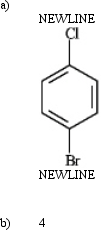
4
Treatment of tert-butyl alcohol with hydrogen chloride yields a mixture of tert-butyl chloride and 2-methylpropene.

a)After chromatographic separation, how would you use 1H NMR to help you decide which was which?
b)How would the 13C NMR for the two compounds differ?

a)After chromatographic separation, how would you use 1H NMR to help you decide which was which?
b)How would the 13C NMR for the two compounds differ?

Unlock Deck
Unlock for access to all 37 flashcards in this deck.
Unlock Deck
k this deck
5
Which of the following would produce only singlets in an 1H NMR spectrum? 
A)A
B)B
C)C
D)D
E)all of these produce only singlets

A)A
B)B
C)C
D)D
E)all of these produce only singlets

Unlock Deck
Unlock for access to all 37 flashcards in this deck.
Unlock Deck
k this deck
6
Instructions: For each of the compounds below tell how many signals you would expect the molecule to have in its normal,broadband decoupled 13C NMR spectra.
Number of signals: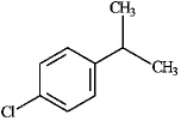
Number of signals:


Unlock Deck
Unlock for access to all 37 flashcards in this deck.
Unlock Deck
k this deck
7
Instructions: For each of the compounds below tell how many signals you would expect the molecule to have in its normal,broadband decoupled 13C NMR spectra.
Number of signals:
Number of signals:


Unlock Deck
Unlock for access to all 37 flashcards in this deck.
Unlock Deck
k this deck
8
Instructions: To answer the following questions,consider the data and 1H NMR spectrum below.

(Spectrum obtained from:SDBSWeb:http://www.aist.go.jp/RIODB/SDBS/)
The mass spectrum of this compound shows a molecular ion at m/z = 113,the IR spectrum has characteristic absorptions at 2270 and 1735 cm-1,and the 13C NMR spectrum has five signals.
Refer to instructions.Based on the mass spectral data and the IR data,what functional groups are present in this compound?

(Spectrum obtained from:SDBSWeb:http://www.aist.go.jp/RIODB/SDBS/)
The mass spectrum of this compound shows a molecular ion at m/z = 113,the IR spectrum has characteristic absorptions at 2270 and 1735 cm-1,and the 13C NMR spectrum has five signals.
Refer to instructions.Based on the mass spectral data and the IR data,what functional groups are present in this compound?

Unlock Deck
Unlock for access to all 37 flashcards in this deck.
Unlock Deck
k this deck
9
Instructions: Predict the splitting patterns you would expect for each proton in the molecules below:
Predict:
Predict:


Unlock Deck
Unlock for access to all 37 flashcards in this deck.
Unlock Deck
k this deck
10
Instructions: Predict the splitting patterns you would expect for each proton in the molecules below:
Predict: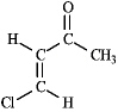
Predict:


Unlock Deck
Unlock for access to all 37 flashcards in this deck.
Unlock Deck
k this deck
11
Which of the following compounds would produce the most downfield signal in a 13C NMR spectrum? 
A)A
B)B
C)C
D)D

A)A
B)B
C)C
D)D

Unlock Deck
Unlock for access to all 37 flashcards in this deck.
Unlock Deck
k this deck
12
Instructions: Refer to the structure of 3-methylbutan-2-one below to answer the following question(s). 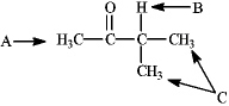
Refer to instructions.What is the splitting pattern for the hydrogens in 3-methylbutan-2-one labeled A,B,and C,respectively?
A)singlet,singlet,singlet
B)singlet,septet,quartet
C)singlet,septet,doublet
D)singlet,septet,doublet,doublet

Refer to instructions.What is the splitting pattern for the hydrogens in 3-methylbutan-2-one labeled A,B,and C,respectively?
A)singlet,singlet,singlet
B)singlet,septet,quartet
C)singlet,septet,doublet
D)singlet,septet,doublet,doublet

Unlock Deck
Unlock for access to all 37 flashcards in this deck.
Unlock Deck
k this deck
13
Instructions: For each of the compounds below tell how many signals you would expect the molecule to have in its normal,broadband decoupled 13C NMR spectra.
Number of signals:
Number of signals:


Unlock Deck
Unlock for access to all 37 flashcards in this deck.
Unlock Deck
k this deck
14
Instructions: For each of the compounds below tell how many signals you would expect the molecule to have in its normal,broadband decoupled 13C NMR spectra.
Number of signals:

Number of signals:


Unlock Deck
Unlock for access to all 37 flashcards in this deck.
Unlock Deck
k this deck
15
Arrange the following compounds in order of increasing number of signals in a 13C NMR spectrum.


Unlock Deck
Unlock for access to all 37 flashcards in this deck.
Unlock Deck
k this deck
16
Instructions: Refer to the structure of 3-methylbutan-2-one below to answer the following question(s). 
Refer to instructions.What is the ratio of peak areas upon integration of the spectrum for A,B,and C respectively?
A)3:1:3:3
B)1:1:6
C)1:2:6
D)3:1:6

Refer to instructions.What is the ratio of peak areas upon integration of the spectrum for A,B,and C respectively?
A)3:1:3:3
B)1:1:6
C)1:2:6
D)3:1:6

Unlock Deck
Unlock for access to all 37 flashcards in this deck.
Unlock Deck
k this deck
17
A compound with the molecular formula C5H12O produces only two singlets in the 1H NMR spectrum.
a)Propose a structure for this compound.
b)How many signals would be present in the 13C NMR for this structure?
a)Propose a structure for this compound.
b)How many signals would be present in the 13C NMR for this structure?

Unlock Deck
Unlock for access to all 37 flashcards in this deck.
Unlock Deck
k this deck
18
Nuclear magnetic resonance spectroscopy provides information about a molecule's:
A)conjugated pi electron system.
B)size and formula.
C)carbon-hydrogen framework.
D)functional groups.
A)conjugated pi electron system.
B)size and formula.
C)carbon-hydrogen framework.
D)functional groups.

Unlock Deck
Unlock for access to all 37 flashcards in this deck.
Unlock Deck
k this deck
19
Match a term to each description below.



Unlock Deck
Unlock for access to all 37 flashcards in this deck.
Unlock Deck
k this deck
20
Explain why all protons in a molecule do not absorb rf energy at the same frequency.

Unlock Deck
Unlock for access to all 37 flashcards in this deck.
Unlock Deck
k this deck
21
Which of the following compounds gives a 1H NMR spectrum consisting of only two singlets?
A)CH3OCH2CH2OCH2CH3
B)CH3OCH2CH2CH2CH2OH
C)CH3OC(CH3)2OCH3
D)CH3OCH2CH(CH3)OCH3
A)CH3OCH2CH2OCH2CH3
B)CH3OCH2CH2CH2CH2OH
C)CH3OC(CH3)2OCH3
D)CH3OCH2CH(CH3)OCH3

Unlock Deck
Unlock for access to all 37 flashcards in this deck.
Unlock Deck
k this deck
22
Instructions: To answer the following questions,consider the data and 1H NMR spectrum below.
The mass spectrum of this compound shows a molecular ion at m/z = 113,the IR spectrum has characteristic absorptions at 2270 and 1735 cm-1,and the 13C NMR spectrum has five signals.
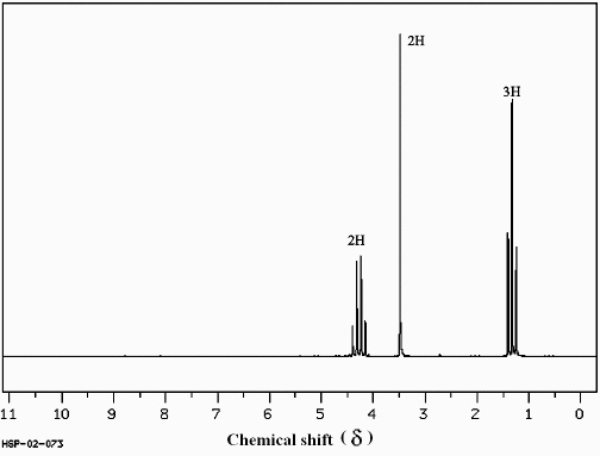
(Spectrum obtained from:SDBSWeb:http://www.aist.go.jp/RIODB/SDBS/)
Refer to instructions.How many types of nonequivalent protons are there in this molecule?
The mass spectrum of this compound shows a molecular ion at m/z = 113,the IR spectrum has characteristic absorptions at 2270 and 1735 cm-1,and the 13C NMR spectrum has five signals.

(Spectrum obtained from:SDBSWeb:http://www.aist.go.jp/RIODB/SDBS/)
Refer to instructions.How many types of nonequivalent protons are there in this molecule?

Unlock Deck
Unlock for access to all 37 flashcards in this deck.
Unlock Deck
k this deck
23
Instructions: Answer the following question(s)for the compound whose 1H NMR spectra is shown below.
C4H8O

(Spectrum obtained from:SDBSWeb:http://www.aist.go.jp/RIODB/SDBS/)
Refer to instructions.Propose a structure for this compound.
C4H8O

(Spectrum obtained from:SDBSWeb:http://www.aist.go.jp/RIODB/SDBS/)
Refer to instructions.Propose a structure for this compound.

Unlock Deck
Unlock for access to all 37 flashcards in this deck.
Unlock Deck
k this deck
24
How many positive and negative peaks appear in the DEPT-135 and in the DEPT-90 spectrum of 2-methylpentane?
A)DEPT-135: two positive and one negative,DEPT-90: one positive
B)DEPT-135: three positive and two negative,DEPT-90: one positive
C)DEPT-135: three positive and two negative,DEPT-90: no signals
D)DEPT-135: two positive and three negative,DEPT-90: two positive
A)DEPT-135: two positive and one negative,DEPT-90: one positive
B)DEPT-135: three positive and two negative,DEPT-90: one positive
C)DEPT-135: three positive and two negative,DEPT-90: no signals
D)DEPT-135: two positive and three negative,DEPT-90: two positive

Unlock Deck
Unlock for access to all 37 flashcards in this deck.
Unlock Deck
k this deck
25
Which structure of molecular formula C4H8Cl2 fits the 1H NMR and 13C NMR spectra shown below? 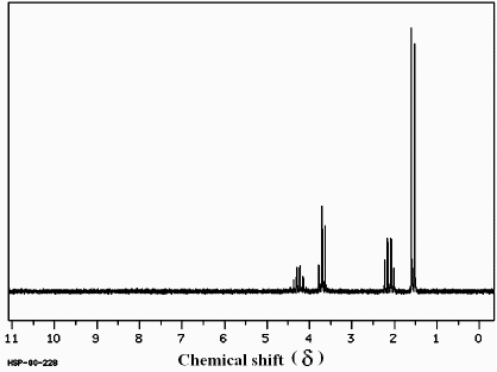

(Spectrum obtained from: SDBSWeb: http://www.aist.go.jp/RIODB/SDBS/)
A)
B)
C)
D)


(Spectrum obtained from: SDBSWeb: http://www.aist.go.jp/RIODB/SDBS/)
A)

B)

C)

D)


Unlock Deck
Unlock for access to all 37 flashcards in this deck.
Unlock Deck
k this deck
26
If the proton attached to C2 in 1,1,2-tribromopropane is coupled with the protons on C1 (J = 3.5 Hz)and C3 (J = 6.8),draw the tree diagram of the C2 proton and predict the splitting pattern.


Unlock Deck
Unlock for access to all 37 flashcards in this deck.
Unlock Deck
k this deck
27
Which of the following combinations of peaks appears in the 1H NMR spectrum of diethyl ether,CH3CH2OCH2CH3?
A)a triplet and a doublet
B)a quartet and a sextet
C)two singlets
D)a triplet and a quartet
A)a triplet and a doublet
B)a quartet and a sextet
C)two singlets
D)a triplet and a quartet

Unlock Deck
Unlock for access to all 37 flashcards in this deck.
Unlock Deck
k this deck
28
How many positive and negative peaks appear in the DEPT-135 spectrum of 2,4-dimethylpentane?
A)two positive and one negative
B)three positive and two negative
C)four positive and three negative
D)six positive and one negative
A)two positive and one negative
B)three positive and two negative
C)four positive and three negative
D)six positive and one negative

Unlock Deck
Unlock for access to all 37 flashcards in this deck.
Unlock Deck
k this deck
29
Which feature in the 1H NMR spectrum provides information about the relative numbers of hydrogen atoms of each type found in a compound?
A)number of signals
B)integration of signals
C)splitting of signals
D)chemical shift
A)number of signals
B)integration of signals
C)splitting of signals
D)chemical shift

Unlock Deck
Unlock for access to all 37 flashcards in this deck.
Unlock Deck
k this deck
30
Which of the following compounds gives a 1H NMR spectrum consisting of only a singlet and two signals in the 13C NMR?
A)1,1-dibromopropane
B)1,2-dibromopropane
C)1,3-dibromopropane
D)2,2-dibromopropane
A)1,1-dibromopropane
B)1,2-dibromopropane
C)1,3-dibromopropane
D)2,2-dibromopropane

Unlock Deck
Unlock for access to all 37 flashcards in this deck.
Unlock Deck
k this deck
31
Which of the following combinations of peaks appears in the 1H NMR spectrum of 2-methylpropane?
A)two singlets
B)a singlet and a nonet
C)a singlet and a decet
D)a doublet and a decet
A)two singlets
B)a singlet and a nonet
C)a singlet and a decet
D)a doublet and a decet

Unlock Deck
Unlock for access to all 37 flashcards in this deck.
Unlock Deck
k this deck
32
Which feature in the 1H NMR spectrum provides information about the electronic environment of the protons in a compound?
A)number of signals
B)integration of signals
C)splitting of signals
D)chemical shift
A)number of signals
B)integration of signals
C)splitting of signals
D)chemical shift

Unlock Deck
Unlock for access to all 37 flashcards in this deck.
Unlock Deck
k this deck
33
Which feature in the 1H NMR spectrum provides information about the number of neighboring protons of each proton in the compound?
A)number of signals
B)integration of signals
C)splitting of signals
D)chemical shift
A)number of signals
B)integration of signals
C)splitting of signals
D)chemical shift

Unlock Deck
Unlock for access to all 37 flashcards in this deck.
Unlock Deck
k this deck
34
How many sets of equivalent protons are there in hexane,2-methylhexane,and 3-methylhexane,respectively?

Unlock Deck
Unlock for access to all 37 flashcards in this deck.
Unlock Deck
k this deck
35
Instructions: Answer the following question(s)for the compound whose 1H NMR spectra is shown below.
C4H8O
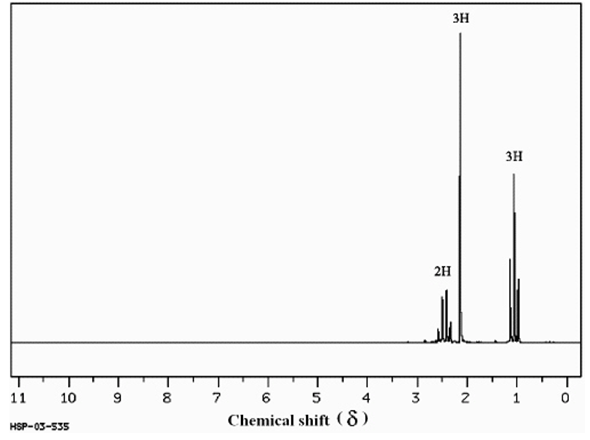
(Spectrum obtained from:SDBSWeb:http://www.aist.go.jp/RIODB/SDBS/)
Refer to instructions.Describe each signal in terms of its integration,splitting and chemical shift.
C4H8O

(Spectrum obtained from:SDBSWeb:http://www.aist.go.jp/RIODB/SDBS/)
Refer to instructions.Describe each signal in terms of its integration,splitting and chemical shift.

Unlock Deck
Unlock for access to all 37 flashcards in this deck.
Unlock Deck
k this deck
36
How many signals appear in the broadband-decoupled 13C NMR spectrum of 1,3-dibromobenzene?
A)1
B)2
C)3
D)4
A)1
B)2
C)3
D)4

Unlock Deck
Unlock for access to all 37 flashcards in this deck.
Unlock Deck
k this deck
37
How many signals appear in the broadband-decoupled 13C NMR spectrum of 1,2-dibromobenzene?
A)1
B)2
C)3
D)4
A)1
B)2
C)3
D)4

Unlock Deck
Unlock for access to all 37 flashcards in this deck.
Unlock Deck
k this deck



